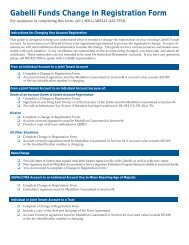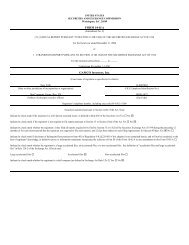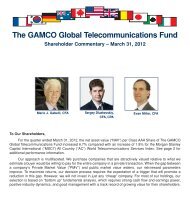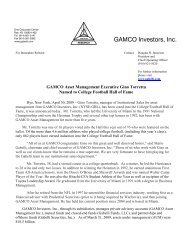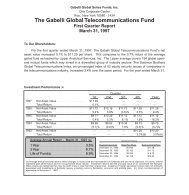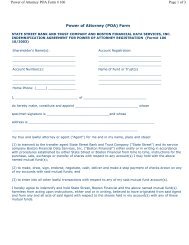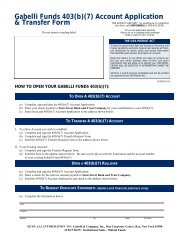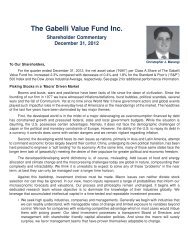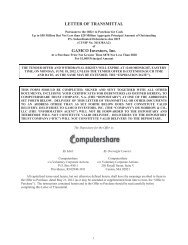Statement of Additional Info - Gabelli
Statement of Additional Info - Gabelli
Statement of Additional Info - Gabelli
You also want an ePaper? Increase the reach of your titles
YUMPU automatically turns print PDFs into web optimized ePapers that Google loves.
dividends (as defined in the Code) received by the Fund from domestic corporations for the taxable year. In addition, the<br />
dividends-received deduction for a corporate shareholder will be disallowed for shareholders who do not hold their<br />
shares in a Fund for at least 46 days during the 91-day period beginning 45 days before a share in the Fund becomes ex<br />
dividend with respect to such dividend and will be disallowed with respect to an investment in the Fund that is debt<br />
financed. Shareholders will be notified at the end <strong>of</strong> the year as to the amount <strong>of</strong> the dividends that qualify for the<br />
dividends-received deduction.<br />
Alternative minimum tax (“AMT”) is imposed in addition to, but only to the extent it exceeds, the regular tax. For<br />
purposes <strong>of</strong> the corporate AMT, the corporate dividends-received deduction is not itself an item <strong>of</strong> tax preference that<br />
must be added back to taxable income or is otherwise disallowed in determining a corporation’s alternative minimum tax<br />
income (“AMTI”). However, a corporate shareholder will generally be required to take the full amount <strong>of</strong> any dividend<br />
received from the Fund into account (without a dividends-received deduction) in determining its adjusted current<br />
earnings, which are used in computing an additional corporate preference item (i.e., 75% <strong>of</strong> the excess <strong>of</strong> a corporate<br />
taxpayer’s adjusted current earnings over its AMTI, determined without regard to this item and the AMT net operating<br />
loss deduction) includable in AMTI.<br />
Distributions are taxable to shareholders whether received in cash or reinvested in additional shares <strong>of</strong> the Fund.<br />
Shareholders receiving a distribution in the form <strong>of</strong> additional shares will be treated as receiving a distribution in an<br />
amount equal to the amount <strong>of</strong> the cash dividend that otherwise would have been distributable (where the additional<br />
shares are purchased in the open market), or the fair market value <strong>of</strong> the shares received, determined as <strong>of</strong> the<br />
reinvestment date. Shareholders electing to receive distributions in the form <strong>of</strong> additional shares will have a cost basis for<br />
U.S. federal income tax purposes in each share so received equal to the value <strong>of</strong> a share on the reinvestment date.<br />
In general, gain or loss recognized by a Fund on the disposition <strong>of</strong> an asset will be a capital gain or loss. However, gain<br />
recognized on the disposition <strong>of</strong> a debt obligation purchased by the Fund at a market discount (generally, at a price less<br />
than its principal amount) will be treated as ordinary income to the extent <strong>of</strong> the portion <strong>of</strong> the market discount which<br />
accrued during the period <strong>of</strong> time the Fund held the debt obligation.<br />
Certain <strong>of</strong> the options, futures contracts, and forward foreign currency exchange contracts in which certain <strong>of</strong> the Funds<br />
may invest are so-called "section 1256 contracts." With certain exceptions, realized gains or losses on section 1256<br />
contracts generally are considered 60% long term and 40% short term capital gains or losses ("60/40"). Also, section<br />
1256 contracts held by a Fund at the end <strong>of</strong> each taxable year (and, generally, for purposes <strong>of</strong> the nondeductible 4%<br />
excise tax, on October 31 <strong>of</strong> each year) are "marked-to-market" with the result that unrealized gains or losses are treated<br />
as though they were realized and the resulting gain or loss is treated as 60/40 gain or loss. Investors should consult their<br />
own tax advisers in this regard.<br />
Generally, the hedging transactions undertaken by a Fund may result in "straddles" for U.S. federal income tax purposes.<br />
The straddle rules may affect the character <strong>of</strong> gains (or losses) realized by a Fund. In addition, losses realized by a Fund<br />
on a position that is part <strong>of</strong> a straddle may be deferred under the straddle rules, rather than being taken into account in<br />
calculating the taxable income for the taxable year in which such losses are realized. Since only a few regulations<br />
implementing the straddle rules have been promulgated, the tax consequences to a Fund <strong>of</strong> hedging transactions are not<br />
entirely clear. A Fund may make one or more <strong>of</strong> the elections applicable to straddles available under the Code. If an<br />
election is made, the amount, character, and timing <strong>of</strong> the recognition <strong>of</strong> gains or losses from the affected straddle<br />
positions will be determined pursuant to the rules applicable to the election(s) made, which may accelerate the<br />
recognition <strong>of</strong> gains or losses from the affected straddle positions.<br />
Because application <strong>of</strong> the straddle rules may affect the character <strong>of</strong> gains or losses, defer losses, and/or accelerate the<br />
recognition <strong>of</strong> gains or losses from the affected straddle positions, the amount which must be distributed to shareholders,<br />
and will be taxed to shareholders as ordinary income or long term capital gain, may be increased or decreased<br />
substantially as compared to a Fund that did not engage in such hedging transactions.<br />
Gains or losses attributable to fluctuations in exchange rates resulting from transactions in a foreign currency generally<br />
are treated as ordinary income or ordinary loss. These gains or losses may increase, decrease, or eliminate the amount <strong>of</strong><br />
a Fund's investment company taxable income to be distributed to its shareholders as ordinary income.<br />
Investors should carefully consider the tax implications <strong>of</strong> buying shares prior to a distribution by the Funds. The price<br />
<strong>of</strong> shares purchased at that time includes the amount <strong>of</strong> the forthcoming distributions. Distributions by a Fund reduce the<br />
NAV <strong>of</strong> the Fund’s shares, and if a distribution reduces the NAV below a stockholder’s cost basis, such distribution,<br />
68




